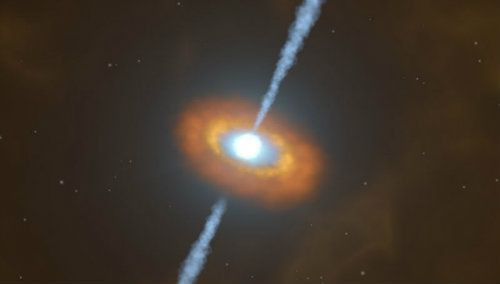Astronomers Discover Jupiter-Size Black Hole Eating Through Milky Way Galaxy

A team of researchers has discovered a new black hole that seems to be eating its way through the Milky Way galaxy. According to the researchers, the black hole is currently about as big as Jupiter.
The researchers made the discovery through the help of the Atacama Large Millimeter/Submillimeter Array (ALMA), a set of 66 telescopes located in the Atacama Desert in Chile.
Black holes cannot be observed or spotted directly using telescopes that rely on light, x-rays or other electromagnetic radiation. Despite this, the researchers were still able to detect the presence of a black hole due to the anomaly it caused within the Milky Way galaxy.
After observing distant interstellar gas clouds, the researchers noticed ripples in them. The clouds also displayed strange behavior through the spinning movement of their gases around an unseen center. This led researchers to conclude that an invisible force is affecting the gas clouds.
“When I checked the ALMA data for the first time, I was really excited because the observed gas showed obvious orbital motions, which strongly suggest an invisible massive object lurking,” Shunya Takekawa of the National Astronomical Observatory of Japan and lead author of the study told New Scientist.
Through further observations, Takekawa and his team discovered that the invisible center where the gas clouds were spinning around was as big as Jupiter. They also noted that the unseen object has a mass that’s 30,000 times greater that than of the Sun. Based on the collected data, the researchers concluded that a black hole was sitting at the center of the gas clouds.
Aside from the black hole’s discovery, the researchers also highlighted in their study the new approach when it comes to detecting other black holes in the galaxy, which is observing the behavior of gas clouds.
“We report the discovery of molecular gas streams orbiting around an invisible massive object in the central region of our galaxy,” the researchers stated in the abstract of their study.
“Our results provide new circumstantial evidence for a wandering intermediate-mass black hole in the galactic center, suggesting also that high-velocity compact clouds can be probes of quiescent black holes abound in our galaxy,” they added.
As indicated in their observations, the black hole is currently eating its way through the Milky Way by devouring nearby gas clouds. But since it is not very big, it will most likely not pose a threat to Earth or the galaxy.
© Copyright IBTimes 2025. All rights reserved.





















